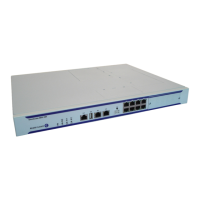Internet Enhanced Services
7750 SR OS Services Guide Page 671
Table 22 lists the SRRP’s state effect on subscriber hosts associated with group IP interfaces.
Table 1: SRRP State Effect on Subscriber Hosts Associated with Group IP Interface
SRRP State ARP Local Proxy ARP
Enabled
Remote Proxy
ARP Enabled
Subscriber Host
Routing
Disabled • Responds to ARP
for all owned
subscriber subnet
IP addresses.
• Will not respond to
ARP for subscriber
subnet SRRP
gateway IP
addresses.
• All ARP responses
will contain the
native MAC of the
group IP interface
(not the SRRP
gateway MAC).
• Responds to ARP
for all subscriber
hosts on the
subscriber subnet.
• Respondsto ARP
for all reachable
remote IP hosts.
• All routing out the
group IP interface
will use the native
group IP interface
MAC address.
• The group IP
interface redundant
IP interface will not
be used.
• Will not accept
packets destined to
the SRRP gateway
MAC received on
the group IP
interface.
Becoming Master
(In order to enter
becoming master
state, a master must
currently exist)
• Responds to ARP
for all owned
subscriber subnet
IP addresses
(hardware address
and source MAC =
group IP interface
native MAC).
• Responds to ARP
for subscriber
subnet SRRP
gateway IP
addresses(hardware
address = SRRP
gateway IP
address,source
MAC = group IP
interface native
MAC).
• Responds to ARP
for all subscriber
hosts on the
subscriber subnet
(hardware address
= SRRP gateway
MAC address,
source MAC =
group IP interface
native MAC).
• Responds to ARP
for all reachable
remote IP hosts
(hardware address
= SRRP gateway
MAC address,
source MAC =
group IP interface
native MAC).
• All routing out the
group IP interface
use the native group
IP interface MAC
address.
• Subscriber hosts
mapped to the
redundant IP
interface are
remapped to the
group IP interface.
• Will not accept
packets destined to
the SRRP gateway
MAC received on
the group IP
interface.

